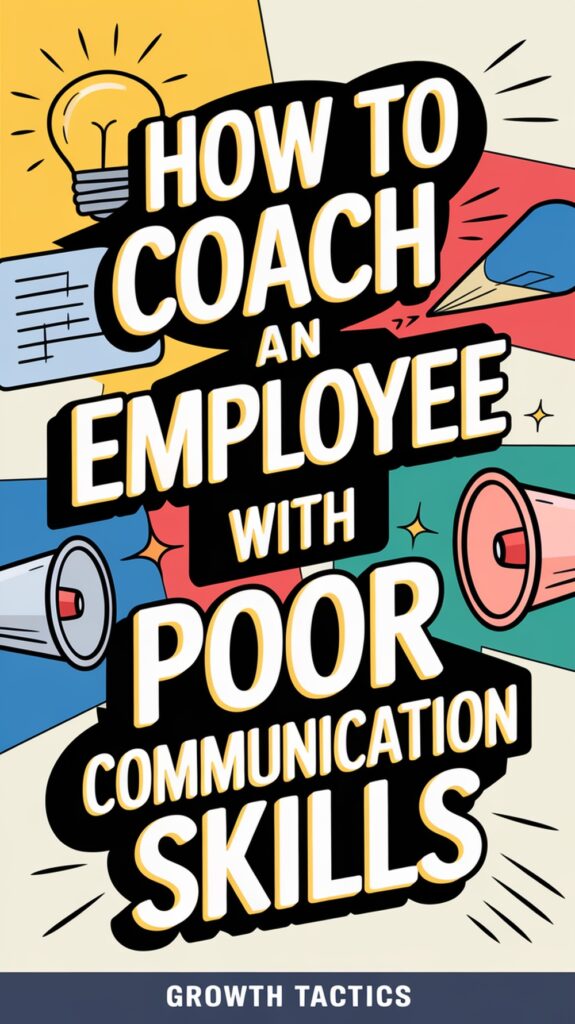Ever had an employee who just can’t seem to get their point across?
Poor communication can turn a great worker into a team’s weak link. But here’s the good news: you can help them improve.
As a leader, I’m sure you know how crucial clear communication is. It’s the glue that holds teams together. When someone struggles with this skill, it affects everyone.
In this article, I’ll walk you through simple steps to coach an employee with poor communication skills.
Ready to make a real difference? Let’s unlock your employee’s potential!
Jump To Section
Identify the Problem
First things first, we need to figure out what’s going wrong. I’ve found that spotting communication issues early can save a lot of headaches later.
Let’s look at some common areas where employees might struggle:
Areas of Poor Communication Skills
Everyone’s different, but I’ve noticed some common trouble spots:
- Active Listening
Some people have a hard time really hearing what others say. They might miss important details or misunderstand instructions. - Non-Verbal Communication
Body language can speak louder than words. Some people don’t realize how their posture or facial expressions come across. - Clarity in Speaking
Getting your point across clearly isn’t always easy. Some struggle to explain complex ideas in simple terms. - Writing Skills
In our email-heavy world, writing clear messages is crucial. Poor writing can lead to confusion and wasted time. - Emotional Intelligence
Understanding and managing emotions, both your own and others’, is key to good communication. - Assertiveness
Some people have trouble speaking up or expressing their needs clearly. - Adaptability
Different situations call for different communication styles. Some folks stick to one approach, even when it’s not working. - Giving and Receiving Feedback
This is tough for many. Both offering constructive criticism and accepting it gracefully are important skills. - Cultural Awareness
In our diverse workplaces, understanding different cultural norms in communication is crucial. - Conflict Resolution
Addressing disagreements head-on in a positive way is a skill many need to work on.
Watch for Signs of Poor Communication
I always keep my eyes peeled for tell-tale signs. Poor communication can sneak up on us, but there are clues if we know where to look.
Here’s what I watch out for:
- Unclear explanations: If someone struggles to get their point across, it’s a red flag.
- Frequent misunderstandings: When instructions are often misheard or misread, we need to pay attention.
- Avoiding eye contact: This might mean they’re uncomfortable or unsure in conversations.
- Interrupting others: It could show they’re not listening well or respecting others’ input.
- Short, vague responses: One-word answers or “I don’t know” might signal a lack of engagement.
- Body language that doesn’t match words: Watch for crossed arms or fidgeting when they say they’re fine.
- Emotional reactions: If they get defensive or angry easily, there might be communication issues.
- Not asking questions: This could mean they’re afraid to speak up or don’t know how to clarify things.
- Dominating conversations: If they talk over others, they might not realize the value of two-way communication.
- Difficulty with written communication: Unclear emails or reports are worth noting.
These signs don’t always mean there’s a big problem. But they’re worth looking into.
Remember, everyone communicates differently. Your job is to help each person find their best way to connect with others.
Ask for Feedback from Team Members
Your team can be a goldmine of information. I like to check in with them regularly. They might notice things you’ve missed. Just remember to keep it confidential and focused on helping, not blaming.
Reflect on Your Own Interactions with the Employee
I take time to think about how I communicate with the employee too. Sometimes, the problem might be on my end. Being honest with myself helps me coach better.
Have a Heart-to-Heart Talk
Once you’ve spotted the issue, it’s time to talk it out. This isn’t about pointing fingers. It’s about finding solutions together.
Set Up a Private Meeting
I always choose a quiet, private spot for these chats. It helps the employee feel more comfortable opening up.
Create a Safe, Open Environment
I start by reassuring them. This talk is to help, not to criticize. I make sure they know that we’re on the same team.
Listen More Than I Speak
Here’s a trick I’ve learned: zip your lip and open your ears. Let them share their thoughts first. You might be surprised by what you learn.
Set Clear Goals Together
Now that we understand the problem, it’s time to plan for success.
Ask What They Want to Improve
I always start with their perspective. What do they think needs work? This gets them invested in the process right from the start.
Share My Observations
Then, I gently share what I’ve noticed. I stick to facts, not judgments. This helps keep the conversation productive.
Agree on Specific, Achievable Targets
Together, we set goals that are clear and doable. I make sure they’re not too easy, but not impossible either. It’s all about finding that sweet spot.
Make an Effective Communication Personal Action Plan
A goal without a plan is just a wish. That’s why we need to map out the road to success.
Break Down Big Goals into Small Steps
I help them chop those big goals into bite-sized chunks.
It makes the task less overwhelming and more achievable.
Set Deadlines for Each Step
We put dates on the calendar for each mini-goal. This keeps us on track and adds a sense of urgency.
Decide How We’ll Measure Progress
Lastly, we figure out how to track improvement.
Maybe it will be fewer misunderstandings in meetings. Or clearer emails. Whatever it is, we make sure it’s something we can actually measure.
Provide Tools and Resources
I believe in setting people up for success when it comes to effective communication in the workplace. That’s why I always make sure my team has the right tools to improve their communication skills.
Here are some of my favorite resources:
Offer Communication Workshops
I’ve found that group learning can be really powerful. Bring in experts to teach fun, interactive workshops. These sessions give everyone a chance to practice and learn together.
- Toastmasters International: They offer local clubs where you can practice public speaking.
- Dale Carnegie Training: Their workshops focus on communication and leadership.
- VitalSmarts: They have great courses on crucial conversations and influencing skills.
Suggest Books or Online Courses
Sometimes, self-study is the way to go. I keep a list of my favorite books and online courses about communication. I share these with my team and let them choose what works best for them.
Books I love:
- “Crucial Conversations” by Patterson, Grenny, McMillan, and Switzler
- “How to Win Friends and Influence People” by Dale Carnegie
- “Talk Like TED” by Carmine Gallo
Online courses that work:
- Coursera’s “Improving Communication Skills” from the University of Pennsylvania
- LinkedIn Learning’s “Communication Foundations” course
- Udemy’s “Complete Communication Skills Master Class for Life”
I also use communication tools in our daily work:
- Slack for quick team chats
- Zoom for video meetings
- Grammarly to help with writing
Set Up Practice Sessions with Teammates
Nothing beats real-world practice. Arrange mini-sessions where team members can work on their skills together. It’s amazing how much they can learn from each other.
Give Regular Feedback
Feedback is like water for a plant, it’s essential for growth. I make sure to give it often and in a way that’s helpful, not hurtful.
Schedule Weekly Check-ins
I set up short, regular meetings with my team members. This gives us both a chance to talk about what’s working and what’s not.
Praise Improvements, No Matter How Small
I always keep an eye out for progress. Even tiny steps forward deserve a pat on the back.
This keeps people motivated to keep trying.
Offer Constructive Criticism with Kindness
When things need work, I speak up. But I do it gently and with specific suggestions for improvement.
My goal is to help, not to tear down.
Lead by Example
I can’t expect my team to communicate well if I don’t do it myself. That’s why I make sure to walk the talk.
Model Good Communication in My Own Work
I pay extra attention to how I communicate. Clear emails, active listening in meetings, and open body language. I try to do it all.
Invite the Employee to Observe My Interactions
Sometimes, I ask team members to watch how I handle different communication situations. It’s like a live demo of good practices.
Share My Own Communication Challenges and Solutions
I’m not perfect, and I make sure my team knows that. I tell them about times I’ve struggled and how I’ve worked to get better.
It shows them that growth is always possible.
Celebrate Wins and Learn from Setbacks
Every step of the journey matters. I make sure we acknowledge the good and learn from the not-so-good.
Recognize Progress Publicly
When someone improves, I share it with the team. This not only makes the person feel good but also inspires others.
Discuss Obstacles Without Blame
If things don’t go as planned, we talk about it. But we focus on solutions, not on pointing fingers. It’s about moving forward, not looking back.
Adjust the Plan as Needed
I’m always ready to change our approach if it’s not working. Flexibility is key in helping people grow.
Evaluate Overall Progress
After some time, it’s important to step back and look at the big picture.
Review Initial Goals After a Set Period
I sit down with the team member to look at our original goals. We see how far we’ve come and what’s left to do.
Get Feedback from Other Team Members
I check in with the rest of the team too. They often notice improvements that might have slipped past me.
Decide on Next Steps Together
Based on what we’ve learned, we plan our next move. Maybe we set new goals, or maybe we keep working on the old ones. Whatever we decide, we do it as a team.
Conclusion
Coaching an employee with poor communication skills isn’t always easy, but it’s worth it. Remember, everyone has their own unique way of learning and growing. Your job is to guide them, not force them.
I’ve seen firsthand how these steps can transform an employee from a poor communicator to a team star.
It takes time and patience, but the results are amazing.


